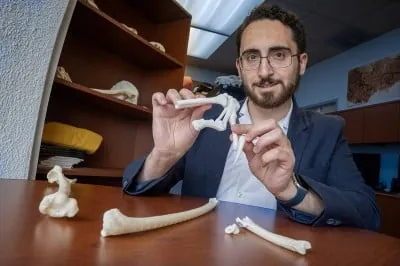
Breaking News: Dinosaur Wrist Bones Could Rewrite the Story of Flight Evolution!
2025-07-10
Author: Yu
Revolutionary Find in Dinosaur Fossils!
A groundbreaking analysis of two theropod dinosaur fossils has unveiled a game-changing discovery: these ancient creatures possessed a carpal bone in their wrists known as the pisiform, a crucial component for flight in modern birds. This revelation, led by Dr. James Napoli of Stony Brook University, challenges the long-held belief that theropods lacked this bird-like structure.
What Makes the Pisiform So Special?
The pisiform bone, originally a small sesamoid bone similar to the kneecap, has migrated from its initial position in the wrist to replace the ulnare bone. This shift has significant implications for how birds maneuver their wings. The unique V-shaped notch of the pisiform allows modern birds to flex their wings automatically, preventing dislocation during flight. It serves as an essential component of their forelimb structure and overall flight capability.
The Fossils Under the Microscope!
The two dinosaur fossils under study include a troodontid, reminiscent of the Velociraptor, and an oviraptorid, an unusual bird-like omnivore with a toothless beak. Thanks to outstanding preservation and advanced high-resolution CT scanning, the research team successfully isolated and identified these ancient wrist bones, confirming the existence of migrated pisiforms in non-bird dinosaurs for the very first time.
Evolutionary Implications: A Leap for Dinosaurs!
Dr. Napoli expressed excitement over these findings, noting, "This is the first identification of a migrated pisiform in meat-eating dinosaurs. While we are still uncertain how many times dinosaurs experimented with flight, it’s fascinating to consider that these ventures began only after the pisiform shifted into this crucial position. This may have laid the foundation for the automatic mechanisms seen in today’s flying birds."
A New Chapter in the Dinosaur Flight Theory!
The evolutionary context of this discovery is just as thrilling. The research reveals that the pisiform’s migration occurred not within birds but alongside the evolution of a theropod subgroup called Pennaraptora, which includes Velociraptor-like dromaeosaurids, troodontids, and oviraptorosaurs. These dinosaurs marked the beginnings of bird-like traits such as feathered wings and represent a significant step in the evolution of flight, potentially occurring multiple times across their lineage.
A Step Back in Time: Unraveling Theropod Anatomy!
The team concluded that the introduction of the pisiform in theropods came much earlier in their history than previously thought. Their study sheds light on how classic avian traits—like lightweight bones, larger brains, and feathers—are present in a broader range of theropod dinosaurs. This pivotal research not only shifts our understanding of dinosaur anatomy but also provides compelling evidence that the evolution of the avian wrist is tied to processes initiated with the emergence of Pennaraptora.
What’s Next?
With this exciting new evidence on the table, the quest continues to unravel the intricacies of dinosaur evolution. Future research will be vital to investigate further the connections between wrist anatomy and the flight capabilities of these ancient creatures. Stay tuned as we delve deeper into the captivating world of dinosaurs and their evolutionary journey!


 Brasil (PT)
Brasil (PT)
 Canada (EN)
Canada (EN)
 Chile (ES)
Chile (ES)
 Česko (CS)
Česko (CS)
 대한민국 (KO)
대한민국 (KO)
 España (ES)
España (ES)
 France (FR)
France (FR)
 Hong Kong (EN)
Hong Kong (EN)
 Italia (IT)
Italia (IT)
 日本 (JA)
日本 (JA)
 Magyarország (HU)
Magyarország (HU)
 Norge (NO)
Norge (NO)
 Polska (PL)
Polska (PL)
 Schweiz (DE)
Schweiz (DE)
 Singapore (EN)
Singapore (EN)
 Sverige (SV)
Sverige (SV)
 Suomi (FI)
Suomi (FI)
 Türkiye (TR)
Türkiye (TR)
 الإمارات العربية المتحدة (AR)
الإمارات العربية المتحدة (AR)